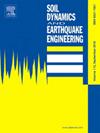Seismic performance of hybrid seismic isolation bearing system: shake table test and nonlinear numerical analysis
IF 4.2
2区 工程技术
Q1 ENGINEERING, GEOLOGICAL
引用次数: 0
Abstract
The hybrid seismic isolation bearing system (HSIBS) is composed of sliding friction bearing and elastomeric bearing, which fulfills the separation of vertical and horizontal force transmission mechanisms. The sliding friction bearing provides vertical support and energy dissipation, while the elastomeric bearing offers self-centering capability. Compared to conventional seismic isolation bearings, such a convenient design of the hybrid bearing system retains higher vertical loading capacity, better flexibility in post-yield stiffness selection, and little interference to traffic during post-earthquake retrofit. Therefore, the system has better adaptability to different seismic design requirements. To evaluate the seismic performance of the bearing system, a 1/3.5 scaled bridge model was designed and subjected to a shake table test. The experimental results demonstrate that the HSIBS exhibits good seismic performance, which significantly reduces the seismic response and residual displacement. Specifically, the maximum deformation of the bearing system is limited to a small level (49 mm), the bridge piers stay within an elastic state under the earthquake input with a peak ground acceleration (PGA) of 0.6 , and the maximum residual displacement of the bearing system is negligible (2.85 mm). In addition, numerical simulations are conducted to verify the test results and analyze the seismic parameters of HSIBS. Parameter optimization of HSIBS is also performed, which achieved the balance of bearing displacement demand and moment of piers, hence enhanced efficiency.
混合隔震支座体系的抗震性能:振动台试验与非线性数值分析
混合隔震支座系统由滑动摩擦支座和弹性支座组成,实现了竖向和水平传力机构的分离。滑动摩擦轴承提供垂直支撑和能量耗散,而弹性轴承提供自定心能力。与传统隔震支座相比,这种方便的设计使混合动力支座系统具有更高的竖向承载能力、屈服后刚度选择的灵活性和震后改造对交通的干扰小。因此,该系统对不同的抗震设计要求具有较好的适应性。为了评估支座体系的抗震性能,设计了1/3.5比例的桥梁模型并进行了振动台试验。实验结果表明,HSIBS具有良好的抗震性能,显著降低了地震反应和残余位移。具体而言,支座系统的最大变形被限制在一个很小的水平(49 mm),桥墩在地震输入下保持弹性状态,峰值地面加速度(PGA)为0.6 g,支座系统的最大残余位移可以忽略不计(2.85 mm)。此外,通过数值模拟对试验结果进行了验证,并对HSIBS的地震参数进行了分析。对HSIBS进行了参数优化,实现了支座位移需求与桥墩弯矩的平衡,提高了效率。
本文章由计算机程序翻译,如有差异,请以英文原文为准。
求助全文
约1分钟内获得全文
求助全文
来源期刊

Soil Dynamics and Earthquake Engineering
工程技术-地球科学综合
CiteScore
7.50
自引率
15.00%
发文量
446
审稿时长
8 months
期刊介绍:
The journal aims to encourage and enhance the role of mechanics and other disciplines as they relate to earthquake engineering by providing opportunities for the publication of the work of applied mathematicians, engineers and other applied scientists involved in solving problems closely related to the field of earthquake engineering and geotechnical earthquake engineering.
Emphasis is placed on new concepts and techniques, but case histories will also be published if they enhance the presentation and understanding of new technical concepts.
 求助内容:
求助内容: 应助结果提醒方式:
应助结果提醒方式:


